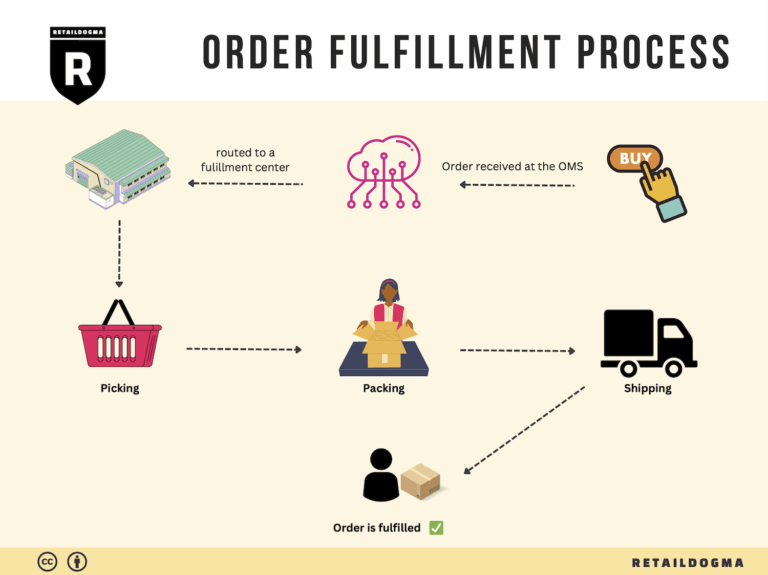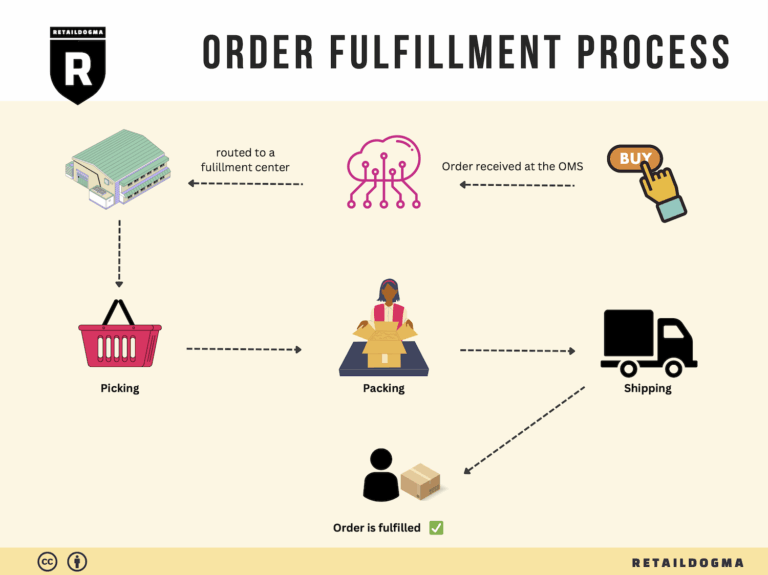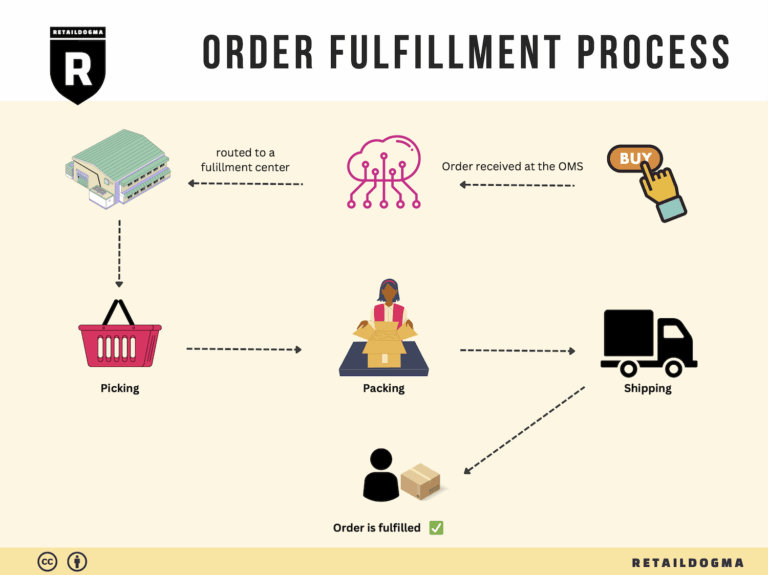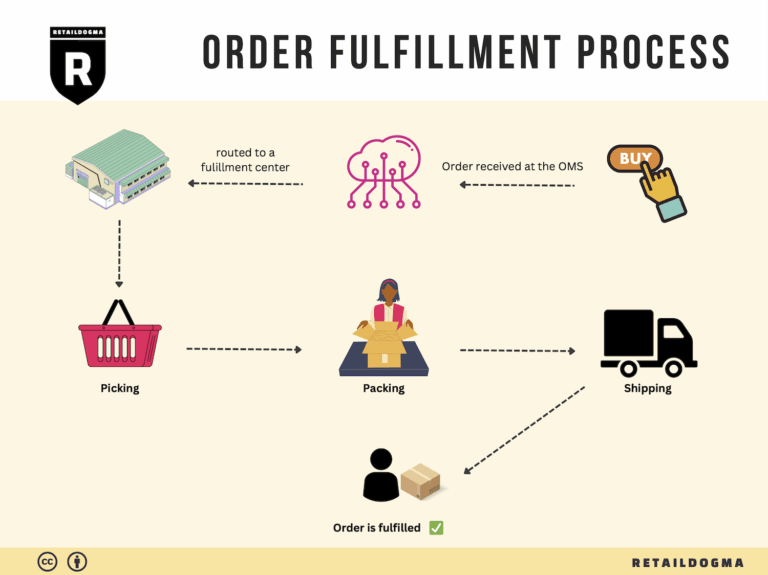How Order Fulfillment Works: A Step-by-Step Guide for Businesses
What is E-commerce Fulfillment? An Introduction for Growing Businesses
Understanding E-commerce Fulfillment: The Key to Scaling Your Business
As a growing online business, you may find yourself overwhelmed by the myriad of tasks that come with packing and shipping orders. The excitement of making sales can quickly turn into frustration when you realize that fulfilling those orders efficiently is a complex process. E-commerce fulfillment is essentially the backbone of your operations, representing the entire journey of getting a product from your inventory to your customer’s doorstep. This involves not just the physical aspects of packing and shipping, but also inventory management, order processing, and returns handling.
In this guide, we will demystify e-commerce fulfillment and provide you with the knowledge needed to navigate this critical component of your business. We will explore different fulfillment models available to you, including Third-Party Logistics (3PL) and Fulfillment by Amazon (FBA). Each model has its own advantages and considerations, and understanding these will help you choose the right one for your business needs.
We will also delve into the core services that fulfillment partners typically offer, such as warehousing, picking and packing, inventory management, and shipping logistics. Knowing what services are available can help you streamline your operations and focus on growing your sales rather than getting bogged down in logistics.
Choosing the right fulfillment partner is a crucial decision that can significantly impact your business’s efficiency and customer satisfaction. We will outline key factors to consider when evaluating potential partners, including their technology capabilities, customer service, and pricing structures. Transparent pricing is essential, as it allows you to budget effectively and maintain healthy profit margins.
Finally, the goal of this guide is to empower you with the knowledge to make informed decisions about your e-commerce fulfillment strategy. With the right approach, you can transform your logistics from a source of stress into a competitive advantage, enabling you to scale your business effectively. Whether you are just starting out or looking to optimize your existing processes, this guide will serve as a valuable resource in your e-commerce journey.
What You’ll Learn In This Guide
- What is E-commerce Fulfillment? An Introduction for Growing Businesses
- The Order Fulfillment Process: From ‘Buy’ Button to Customer’s Door
- Comparing Fulfillment Models: In-House vs. 3PL vs. Dropshipping
- A Deep Dive into Amazon FBA: Pros, Cons, and Who It’s For
- Core Services Offered by Fulfillment Centers
- How to Choose a Fulfillment Partner: A 6-Point Checklist
- Understanding Fulfillment Pricing: A Breakdown of Common Fees
- Frequently Asked Questions (FAQs) about Fulfillment
- Conclusion: Is Outsourcing Fulfillment the Right Move for Your Business?
- Important Disclaimer
The Order Fulfillment Process: From ‘Buy’ Button to Customer’s Door
1. Receiving Inventory
The order fulfillment process begins with receiving inventory, which is a critical step in ensuring that your e-commerce operations run smoothly. When your products arrive at the fulfillment center, they undergo a thorough inspection to confirm that the right items and quantities have been delivered. This is where SKU (Stock Keeping Unit) numbers come into play; they help track and manage inventory levels effectively.
Receiving inventory is important because it sets the foundation for the entire fulfillment process. Any discrepancies or damages identified at this stage can be addressed immediately, preventing costly errors later. Additionally, accurate receiving processes help maintain good relationships with suppliers and ensure that you have the necessary stock to meet customer demand.
2. Warehouse Storage
Once inventory has been received and inspected, it is then organized and stored in the fulfillment center. Efficient warehouse storage involves categorizing products based on various factors such as size, type, and demand frequency. This organization allows for easier access during the picking process. Inventory management systems (IMS) are often employed at this stage to track the location and quantity of items, making it easier to manage stock levels and avoid overstocking or stockouts.
Proper warehouse storage is crucial because it directly impacts the efficiency of order fulfillment. The faster and more accurately products can be retrieved, the quicker orders can be processed and shipped. Additionally, effective storage solutions can reduce operational costs and maximize the use of warehouse space.
3. Order Picking
The next step in the fulfillment process is order picking, where items are selected from storage to fulfill customer orders. A pick list is generated, detailing the specific items and quantities needed for each order. This list guides warehouse staff in collecting the correct products, ensuring accuracy and efficiency.
Order picking is vital for customer satisfaction; incorrect or incomplete orders can lead to returns and negatively impact your brand reputation. By implementing efficient picking strategies, such as batch picking or zone picking, businesses can streamline this process, reduce labor costs, and enhance order accuracy.
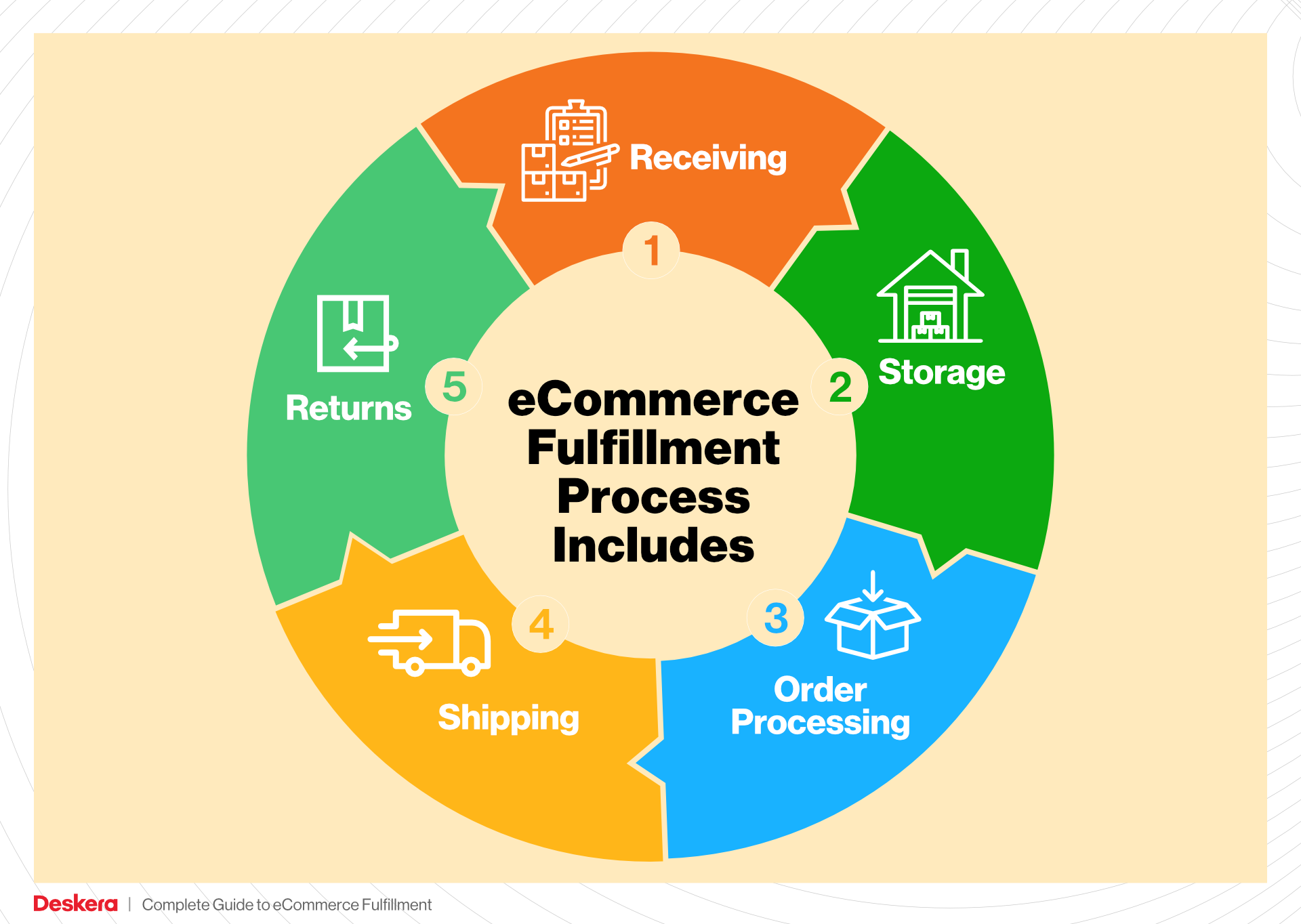
4. Order Packing
After the items have been picked, they move on to the packing stage. Here, products are carefully packaged for shipping, which may involve selecting appropriate box sizes, packing materials, and labeling. It’s essential to consider custom packaging options during this step, as they can enhance the unboxing experience for customers and reduce the likelihood of damage during transit.
Order packing is crucial because it not only protects products but also reflects your brand’s commitment to quality and customer service. Well-packed orders can lead to fewer returns and higher customer satisfaction rates. Moreover, efficient packing processes can optimize shipping costs and improve delivery times.
5. Shipping & Delivery
The final step in the order fulfillment process is shipping and delivery. Once orders are packed, they are handed over to shipping carriers for distribution. It’s essential to have a reliable shipment management technology in place to track packages, manage shipping costs, and provide customers with real-time updates on their order status.
Shipping and delivery are critical as they directly impact the customer experience. Fast and reliable shipping can lead to repeat purchases and positive reviews, while delays can harm your brand’s reputation. By offering various shipping options, such as standard and express delivery, businesses can cater to different customer preferences and enhance satisfaction.
In conclusion, understanding and optimizing each step of the order fulfillment process—from receiving inventory to shipping—can significantly improve your e-commerce operations. By focusing on efficiency, accuracy, and customer satisfaction throughout these stages, businesses can scale successfully and maintain a competitive edge in the market.
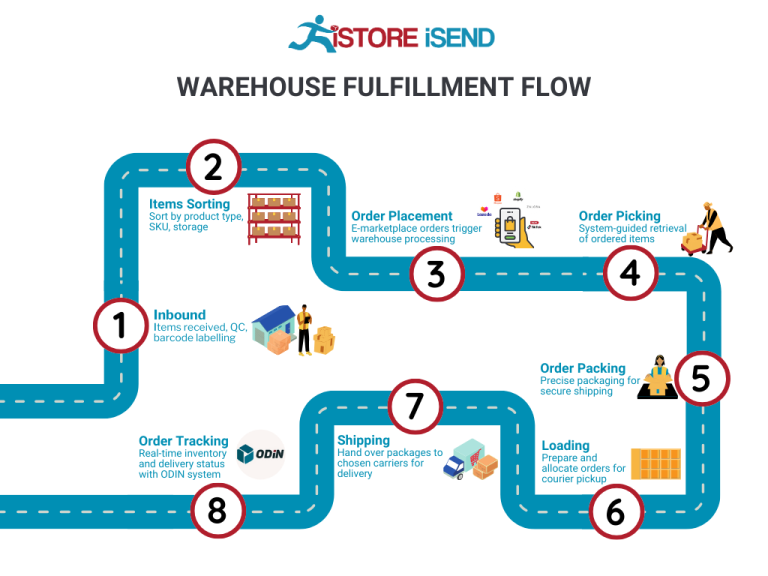
Comparing Fulfillment Models: In-House vs. 3PL vs. Dropshipping
Fulfillment Model Comparison
| Model | Who Handles Inventory | Best For (Business Stage) | Key Advantage | Key Disadvantage |
|---|---|---|---|---|
| In-House Fulfillment | The business itself | Startups to established | Greater control over inventory and processes | High overhead costs and resource-intensive |
| Third-Party Logistics (3PL) | Third-party provider | Growth-stage businesses | Scalable solutions and expertise | Less control over fulfillment processes |
| Dropshipping | Supplier | Startups and small businesses | Low startup costs and no inventory risk | Lower profit margins and reliance on suppliers |
In-House Fulfillment
In-house fulfillment involves managing the entire inventory and shipping process within your own business infrastructure. This model is particularly beneficial for startups transitioning into established brands, as it allows for greater control over inventory management, order processing, and customer service. By handling fulfillment in-house, businesses can tailor their logistics processes to meet specific operational needs and customer expectations. This level of control can enhance the customer experience, as businesses can ensure timely deliveries and maintain quality standards throughout the shipping process. However, the downside is significant; in-house fulfillment can lead to high overhead costs due to warehousing, staffing, and logistics management. Additionally, it requires a substantial investment in technology and infrastructure, making it a resource-intensive option that may not be sustainable for all businesses, especially those looking to scale rapidly.
Third-Party Logistics (3PL)
Third-party logistics (3PL) providers offer outsourced fulfillment services that can significantly streamline logistics operations for e-commerce businesses. This model is ideal for growth-stage businesses seeking to scale efficiently without the burden of managing inventory and shipping on their own. A reputable 3PL partner brings expertise in logistics, technology, and inventory management, allowing businesses to focus on their core competencies like marketing and product development. 3PL providers typically offer a range of services, including warehousing, order fulfillment, shipping, and returns management, which can all be tailored to meet the unique needs of each business. Furthermore, leveraging a 3PL can help businesses benefit from competitive shipping rates and faster delivery times, especially when serving a broader geographic area. However, the trade-off is a potential loss of control over the fulfillment process. Businesses may find it challenging to manage customer expectations related to shipping times and product availability, which can impact customer satisfaction if not properly coordinated.
Dropshipping
Dropshipping is a fulfillment model where the retailer does not hold any inventory but instead purchases items from a third-party supplier who ships directly to the customer. This approach is particularly suitable for startups and small businesses with limited capital, as it significantly reduces the financial risk associated with inventory management. With dropshipping, businesses can offer a wide variety of products without the need for upfront investment in stock, making it an attractive option for entrepreneurs looking to test new markets or product lines. The low startup costs and ease of entry make dropshipping appealing; however, the model is not without its challenges. Profit margins can be slim due to reliance on suppliers for fulfillment and shipping, which may lead to higher costs for the retailer. Moreover, issues such as inconsistent product quality, longer shipping times, and lack of control over inventory can negatively affect the customer experience. As a result, businesses must carefully vet suppliers and establish strong communication to mitigate these risks.
Conclusion
Choosing the right fulfillment model is critical for the success and scalability of an e-commerce business. Each model—In-House Fulfillment, 3PL, and Dropshipping—offers distinct advantages and disadvantages, making it essential for business owners to evaluate their specific needs, resources, and long-term goals. As businesses grow and evolve, they may find that their fulfillment strategy needs to adapt, shifting from one model to another to best align with their operational capabilities and market demands. By understanding the nuances of each fulfillment model, e-commerce businesses can make informed decisions that enhance efficiency, improve customer satisfaction, and ultimately drive growth.
A Deep Dive into Amazon FBA: Pros, Cons, and Who It’s For
What is Fulfillment by Amazon (FBA)?
Fulfillment by Amazon (FBA) is a service offered by Amazon that allows e-commerce sellers to store their products in Amazon’s fulfillment centers. Amazon takes care of storage, packaging, shipping, and customer service on behalf of the sellers. This service enables sellers to leverage Amazon’s extensive logistics network and customer base, making it easier for them to reach a larger audience and streamline their operations.
When a customer orders a product listed under FBA, Amazon handles the entire fulfillment process. This includes picking the item from the warehouse, packing it, and shipping it directly to the customer. Additionally, Amazon also manages returns and customer service inquiries related to FBA orders, providing a seamless experience for both sellers and customers.
How Does FBA Work?
-
Sign Up and Create Listings: Sellers must sign up for an Amazon seller account and set up their product listings. They can choose which products they want to fulfill through FBA.
-
Ship Inventory to Amazon: Once the listings are created, sellers send their inventory to Amazon’s fulfillment centers. Amazon provides guidelines on how to package and label the products.
-
Storage and Management: After the inventory arrives at the fulfillment center, Amazon stores the products until they are sold. Sellers can monitor their inventory levels through the Amazon Seller Central dashboard.
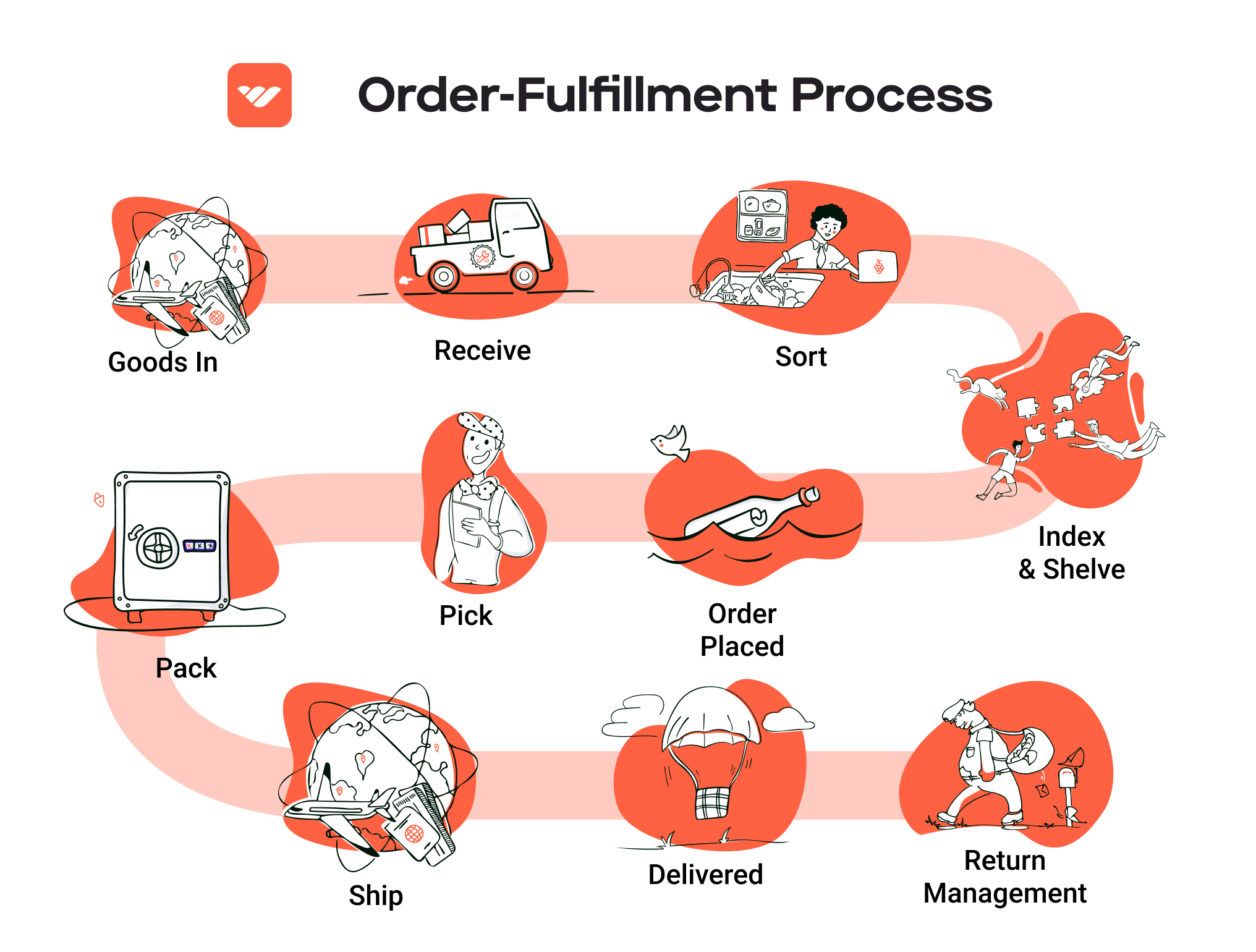
-
Order Fulfillment: When a customer places an order for an FBA product, Amazon picks, packs, and ships the item on behalf of the seller. The seller benefits from Amazon’s shipping rates and logistics expertise.
-
Customer Service and Returns: Amazon handles customer service inquiries related to FBA orders, as well as managing returns, which simplifies the process for sellers.
Pros of Using Amazon FBA
-
Prime Eligibility: One of the most significant advantages of using FBA is that products become eligible for Amazon Prime, which can lead to increased sales. Prime members often prefer products with faster shipping options.
-
Customer Trust: Amazon is a well-known and trusted brand. By utilizing FBA, sellers can benefit from this trust, making customers more likely to purchase from them rather than from unknown sellers.
-
Multi-Channel Fulfillment: FBA allows sellers to fulfill orders from other sales channels, not just Amazon. This means that sellers can integrate their FBA inventory with their own websites or other marketplaces, streamlining their logistics.
-
Scalability: FBA provides a scalable solution for e-commerce businesses. As sales grow, sellers can easily send more inventory to Amazon without needing to invest in their own warehousing and fulfillment infrastructure.
-
Simplified Logistics: Amazon takes care of the logistics, which means sellers can focus on other aspects of their business, such as marketing and product development.
Cons of Using Amazon FBA
-
High Fees: While FBA can simplify logistics, it comes at a cost. Sellers face various fees, including storage fees, fulfillment fees, and additional charges for long-term storage. These fees can significantly impact profit margins, especially for low-cost items.
-
Strict Inventory Rules: Amazon has specific requirements for inventory management, including labeling and packaging standards. Failure to comply with these rules can lead to additional fees or inventory being returned to the seller.
-
Commingling Risks: When using FBA, sellers’ products may be commingled with those of other sellers, which can lead to issues such as receiving damaged or counterfeit items. This can affect the seller’s reputation and customer satisfaction.
-
Loss of Control: By outsourcing fulfillment to Amazon, sellers may feel they lose control over their brand and customer experience. Amazon’s policies can change, impacting how sellers manage their products and customer interactions.
-
Dependency on Amazon: Relying heavily on FBA can create a dependency on Amazon, which may not be sustainable in the long term. Sellers might find it challenging to pivot to other fulfillment methods if needed.
Who is FBA Best For?
Fulfillment by Amazon is particularly well-suited for:
-
Small to Medium-Sized Businesses: Businesses that lack the resources to manage their own fulfillment operations can benefit from FBA’s streamlined logistics and customer service.
-
New Sellers: Entrepreneurs just starting out can leverage Amazon’s infrastructure to gain traction and build their brand without the upfront investment in warehousing and logistics.
-
Sellers with High Volume: Businesses that sell in high volumes can take advantage of Amazon’s economies of scale, potentially lowering their overall fulfillment costs despite the fees.
-
Brands Seeking Visibility: Companies looking to increase their visibility and credibility in the e-commerce space may find that using FBA helps them reach a broader audience.
-
Multi-Channel Sellers: Businesses that sell on multiple platforms can benefit from the multi-channel fulfillment capabilities of FBA, allowing them to manage inventory more efficiently across different sales channels.
In conclusion, while Fulfillment by Amazon offers numerous advantages that can help scale e-commerce businesses, it also comes with its set of challenges. Sellers must carefully weigh these pros and cons to determine if FBA aligns with their business strategy and growth objectives.
Core Services Offered by Fulfillment Centers
Inventory Management & Warehousing
Inventory management and warehousing are fundamental services provided by fulfillment centers. This service involves the systematic tracking of stock levels, orders, sales, and deliveries. Fulfillment centers maintain a well-organized storage system that allows for efficient inventory control, ensuring that products are readily available when needed.
The benefits of effective inventory management are manifold. For e-commerce businesses, it minimizes the risk of stockouts and overstock situations, which can lead to lost sales or increased holding costs. Fulfillment centers utilize advanced Warehouse Management Systems (WMS) that provide real-time visibility into inventory levels, enabling businesses to make informed decisions about restocking and product sourcing. Moreover, with efficient warehousing solutions, businesses can reduce their operational overheads by eliminating the need for extensive in-house storage facilities.
Pick and Pack Services
Pick and pack services are at the heart of the fulfillment process. This service entails the picking of ordered items from the warehouse shelves and packing them for shipment to customers. Fulfillment centers employ trained staff and sophisticated technology to ensure accuracy and efficiency in this process. Each order is carefully picked and packed, often with the option for custom packaging that reflects the brand’s identity.
The primary benefit of pick and pack services for e-commerce businesses is the speed and accuracy of order fulfillment. With consumers increasingly expecting fast shipping, fulfillment centers can significantly reduce the time between order placement and delivery. Additionally, by outsourcing these tasks to experts, businesses can focus on their core competencies, such as marketing and customer engagement, while leaving the logistics to the fulfillment center. This not only streamlines operations but also enhances customer satisfaction through reliable and timely deliveries.
Kitting and Assembly
Kitting and assembly services refer to the process of grouping individual items into ready-to-ship sets or kits. This can include assembling products that require multiple components or creating promotional bundles that enhance the customer purchasing experience. Fulfillment centers are equipped to handle these tasks efficiently, ensuring that products are assembled according to precise specifications and quality standards.
For e-commerce businesses, kitting and assembly provide several advantages. First, this service allows for streamlined order fulfillment by reducing the time spent on preparing individual items for shipping. Bundling products can also lead to increased sales, as customers are often attracted to package deals and promotions. Furthermore, by offering customized kits, businesses can differentiate themselves in a crowded marketplace, creating unique value propositions that resonate with consumers. This enhanced product offering can lead to improved customer retention and loyalty.
Returns Management (Reverse Logistics)
Returns management, often referred to as reverse logistics, is a critical service provided by fulfillment centers. This involves handling the process of returns, from receiving returned items to inspecting, restocking, and managing refunds or exchanges. Effective returns management is essential for maintaining customer satisfaction and loyalty, as it directly impacts the overall shopping experience.
The benefits of robust returns management for e-commerce businesses are significant. A streamlined returns process can enhance customer trust and satisfaction, as consumers are more likely to shop with brands that offer hassle-free return policies. Fulfillment centers typically utilize advanced tracking systems to monitor returns, enabling businesses to analyze return trends and make necessary adjustments to their inventory or product offerings. Additionally, effective reverse logistics can minimize losses associated with returned merchandise by quickly restocking sellable items and managing damaged goods efficiently.
In conclusion, partnering with a fulfillment center provides e-commerce businesses with a suite of core services designed to optimize operations, enhance customer experiences, and drive growth. By leveraging inventory management, pick and pack services, kitting and assembly, and returns management, businesses can focus on scaling their sales and improving their overall logistics strategy while ensuring that their customers receive the best possible service.
How to Choose a Fulfillment Partner: A 6-Point Checklist
Location & Warehouse Network
When selecting a fulfillment partner, the location of their warehouses is crucial. A strategically located warehouse network can significantly reduce shipping times and costs, enhancing customer satisfaction.
Why It Matters:
– Shipping Costs: Proximity to your customer base can lower shipping expenses.
– Delivery Speed: Fast shipping is a competitive advantage in e-commerce.
– Cross-Border Challenges: If you operate in multiple countries, consider potential customs delays.
Questions to Ask:
– Where are your fulfillment centers located?
– How do you optimize shipping routes to ensure timely deliveries?
– Can you support shipping to my key target markets?
Technology & Integrations
In today’s digital world, the technology used by your fulfillment partner can make or break your logistics operations. A robust technology stack ensures seamless integration with your e-commerce platform and real-time inventory management.
Why It Matters:
– Efficiency: Automated systems reduce human error and speed up order processing.
– Visibility: Real-time data helps you monitor inventory levels and order statuses.
– Scalability: Advanced technology allows for easier scaling as your business grows.
Questions to Ask:
– What warehouse management system (WMS) do you use?
– How do you integrate with popular e-commerce platforms (like Shopify, Amazon, etc.)?
– Can you provide real-time tracking for orders?
Specializations (e.g., Cold Storage, Oversized Items)
Different businesses have unique needs, and not all fulfillment centers are equipped to handle specialized products. If you sell items that require specific handling, such as perishables or oversized goods, ensure your partner has the necessary capabilities.
Why It Matters:
– Product Integrity: Proper storage conditions are essential for maintaining product quality.
– Expertise: Partners with specific experience in your product category can better manage your inventory.
Questions to Ask:
– Do you have specialized facilities (like cold storage) for specific products?
– What is your experience with handling oversized or fragile items?
– How do you ensure compliance with industry regulations (e.g., food safety)?
Scalability & Capacity
As your business grows, your fulfillment partner must be able to scale alongside you. Understanding their capacity to handle increased order volumes is vital for long-term success.
Why It Matters:
– Growth Management: A partner that can scale will allow you to focus on expanding your business without worrying about logistics.
– Flexibility: Seasonal spikes in demand require a partner that can quickly adjust to changing order volumes.
Questions to Ask:
– What is your current capacity for order fulfillment?
– How do you handle peak seasons or sudden spikes in demand?
– Are there limits to the number of SKUs I can have in your system?
Pricing and Contracts
Understanding the pricing structure and contract terms is essential for maintaining a healthy bottom line. Hidden fees can quickly erode your profit margins, so transparency is key.
Why It Matters:
– Budgeting: Clear pricing helps you forecast costs accurately.
– Contract Flexibility: A good contract allows you to adapt as your business needs change.
Questions to Ask:
– What is your pricing model (per order, monthly fees, etc.)?
– Are there any additional fees I should be aware of (storage, handling, etc.)?
– Can you provide a sample contract for review?
Customer Support & Reviews
The level of customer support provided by your fulfillment partner can have a significant impact on your operations. Responsive and knowledgeable support can help resolve issues quickly and keep your business running smoothly.
Why It Matters:
– Problem Resolution: Quick access to support can minimize disruptions in your supply chain.
– Trustworthiness: Positive reviews and testimonials indicate reliability and quality service.
Questions to Ask:
– What customer support channels do you offer (phone, email, chat)?
– How do you handle issues or complaints?
– Can you provide references or case studies from similar businesses?
Conclusion
Choosing the right fulfillment partner is a critical step in scaling your e-commerce business. By carefully evaluating potential partners against this checklist, you can ensure that you select a provider that aligns with your operational needs and supports your growth objectives. Taking the time to ask the right questions and thoroughly assess each option will ultimately set your business up for long-term success in a competitive marketplace.
Understanding Fulfillment Pricing: A Breakdown of Common Fees
Initial Setup Fees
Initial setup fees are the charges incurred when you first establish a relationship with a fulfillment provider. These fees can cover a range of services, including account setup, software integration, and the initial onboarding of your products into the fulfillment system. The calculation of these fees can vary widely based on the complexity of your business needs and the fulfillment center’s pricing structure.
For example, some providers may charge a flat fee for setting up your account, which could range from a few hundred to several thousand dollars, depending on the services included. Others might charge based on the number of SKUs being integrated or the level of customization required for your inventory management system. It’s essential to ask for a detailed breakdown of what the initial setup entails to avoid unexpected costs.
Receiving Fees
Receiving fees are charged when your inventory arrives at the fulfillment center. These fees cover the processes involved in inspecting, sorting, and entering your products into the warehouse management system (WMS). Typically, receiving fees are calculated per unit or per shipment, depending on the provider’s pricing model.
For instance, if a fulfillment center charges $0.25 per unit received and you send 1,000 units, your receiving fees would total $250. Some providers may also offer tiered pricing, where the cost per unit decreases as the volume of goods increases. Understanding how these fees are structured can help you budget effectively as you scale your operations.
Storage Fees (per pallet/bin)
Storage fees are incurred for keeping your inventory in the fulfillment center’s warehouse. These fees are generally calculated based on the space your products occupy, typically measured in pallets or bins. Most fulfillment centers have a monthly storage fee, which can range from $10 to $50 per pallet, depending on the location and the provider’s pricing structure.
In addition to monthly storage fees, some providers may also charge for “overage” if your inventory exceeds a certain threshold. For example, if you have a contract that includes free storage for the first 100 pallets and you exceed that limit, you might incur additional charges for the extra pallets stored. It’s crucial to clarify the specifics of storage fees in your contract to avoid surprises.
Pick & Pack Fees (per item/order)
Pick and pack fees are one of the most critical components of fulfillment pricing. These fees cover the labor and materials required to pick items from the shelves, pack them into boxes, and prepare them for shipping. Generally, fulfillment centers charge a fee per item picked or per order fulfilled, with rates typically ranging from $0.50 to $3.00 per item.
For instance, if you have an order with three items and your provider charges $1.00 per item, your pick and pack fee would be $3.00 for that order. Some fulfillment centers offer discounts for larger orders or for clients who ship a high volume of products, so it’s beneficial to inquire about any volume-based pricing that could reduce your costs as you grow.
Shipping Fees
Shipping fees cover the cost of transporting your products from the fulfillment center to your customers. These fees can vary significantly based on several factors, including the shipping method (standard, expedited, etc.), the destination, and the weight and dimensions of the package. Fulfillment centers often negotiate rates with shipping carriers, which can result in competitive pricing passed on to you.
Shipping fees are typically calculated based on a combination of weight and distance. For example, a flat rate might be charged for standard shipping within a certain zone, while additional fees apply for heavier packages or longer distances. Understanding how your fulfillment provider calculates shipping fees can help you choose the most cost-effective shipping options for your business.
Tips for Getting an Accurate Quote
-
Be Transparent: Provide your fulfillment partner with detailed information about your product types, volumes, and order frequency. The more they know about your needs, the more accurate their quote will be.
-
Request a Detailed Breakdown: Ensure that the quote includes a comprehensive breakdown of all potential fees—setup, receiving, storage, pick and pack, and shipping. This transparency will help you understand the overall cost structure.
-
Consider Long-Term Needs: If you plan to scale your business, ask about volume discounts or any fees that may change as your order volume increases.
-
Negotiate: Don’t hesitate to discuss pricing with your fulfillment provider. Many are willing to negotiate terms, especially if you can commit to a long-term partnership.
-
Compare Multiple Quotes: It’s wise to obtain quotes from several fulfillment providers to compare not just pricing but also service levels and capabilities. This comparison can help you make a more informed decision.
By understanding these common fulfillment pricing models and following these tips, you can make strategic decisions that align with your business goals, ensuring a smoother scaling process.
Frequently Asked Questions (FAQs) about Fulfillment
1. What is Yucan Fulfillment?
Yucan Fulfillment refers to the comprehensive logistics services provided by YouCan, which enable e-commerce businesses to manage their order processing, inventory, and shipping seamlessly. It includes features such as product storage, order picking and packing, and shipping, all tailored to help online retailers scale their operations effectively.
2. How does Yucan Fulfillment work?
Yucan Fulfillment operates in a straightforward manner. Once your online store is set up, you list your products in the system. When an order is placed, the Yucan Fulfillment team picks, packs, and ships the product directly to the customer. The entire process is designed to streamline logistics, allowing you to focus on driving sales and growing your business.
3. What’s the difference between a warehouse and a fulfillment center?
A warehouse is primarily focused on storing goods, often for long-term inventory management. In contrast, a fulfillment center is designed specifically for processing orders and shipping products directly to customers. Fulfillment centers typically offer additional services such as order picking, packing, and returns management, which are essential for e-commerce businesses.
4. What is a 3PL (Third-Party Logistics)?
A 3PL, or Third-Party Logistics provider, is a company that offers outsourced logistics services, including warehousing, transportation, and order fulfillment. By partnering with a 3PL like Yucan Fulfillment, e-commerce businesses can leverage specialized expertise, technology, and resources to improve their logistics operations without the need for significant capital investment in infrastructure.
5. How much do fulfillment services cost?
The cost of fulfillment services can vary widely based on factors such as order volume, storage space required, shipping destinations, and additional services like custom packaging. Yucan Fulfillment typically offers transparent pricing structures, allowing businesses to understand the costs associated with storage, picking, packing, and shipping. It’s essential to request a personalized quote to get an accurate estimate tailored to your specific needs.
6. Can I use Yucan Fulfillment for dropshipping?
Yes, Yucan Fulfillment supports dropshipping. This allows you to sell products without holding inventory, as orders are fulfilled directly from suppliers to customers. YouCan provides the necessary tools and integrations to facilitate dropshipping, enabling you to scale your business while minimizing upfront costs.
7. How do I manage my inventory with Yucan Fulfillment?
Yucan Fulfillment offers robust inventory management tools that help you keep track of stock levels, manage reorders, and avoid stockouts. The system allows you to monitor your inventory in real-time, ensuring that you can respond quickly to changes in demand and maintain optimal stock levels.
8. What shipping options are available through Yucan Fulfillment?
Yucan Fulfillment provides various shipping options to meet your business needs. You can choose from standard, expedited, and express shipping services, ensuring that your customers receive their orders in a timely manner. The platform integrates with multiple shipping carriers, allowing you to select the best rates and delivery times for your orders.
9. How does Yucan Fulfillment handle returns?
Yucan Fulfillment has a streamlined returns management process designed to simplify reverse logistics for e-commerce businesses. When a customer initiates a return, the fulfillment center processes it efficiently, updating inventory and providing necessary customer support. This allows you to focus on growing your business rather than getting bogged down by return logistics.
10. What support does Yucan Fulfillment offer to businesses?
Yucan Fulfillment provides dedicated support to its clients, including account management and customer service assistance. You can expect regular communication regarding order processing, inventory management, and any logistics challenges that arise. The support team is equipped to help you optimize your fulfillment strategy, ensuring that you have the resources necessary to scale your business successfully.
Conclusion: Is Outsourcing Fulfillment the Right Move for Your Business?
Evaluating Outsourcing Fulfillment for Your Business
Outsourcing fulfillment can be a transformative decision for e-commerce businesses looking to scale. One of the primary benefits is the significant time savings. By leveraging a fulfillment partner, you can free up valuable resources—allowing you and your team to focus on core business activities such as marketing, customer engagement, and product development. This shift not only enhances operational efficiency but also accelerates growth.
Scalability is another critical advantage. As your business grows, so do the complexities of managing inventory, shipping, and logistics. A dedicated fulfillment service can scale alongside your business, providing the infrastructure and expertise needed to handle increased order volumes without the headaches of maintaining your own warehouse and logistics operations. This allows you to respond quickly to market demands and seasonal fluctuations.
Moreover, partnering with an experienced fulfillment provider offers access to industry expertise and technology that can optimize your supply chain. From advanced inventory management systems to streamlined shipping processes, these services can enhance your overall customer experience, ensuring timely delivery and accurate order processing.
However, the success of outsourcing fulfillment hinges on selecting the right partner. It’s vital to choose a fulfillment service that aligns with your business needs, understands your market, and offers transparent pricing structures. Conducting a thorough audit of your current shipping processes can reveal inefficiencies and help you determine if a fulfillment partner is the right next step.
In conclusion, if you’re looking to elevate your e-commerce business, consider the strategic advantages of outsourcing fulfillment. Take the time to evaluate your current operations and explore how a trusted fulfillment partner can propel your growth journey. The right partnership could very well be the key to unlocking your business’s full potential.
Important Disclaimer
⚠️ Important Disclaimer
The information in this guide is for educational purposes. Fulfillment services, pricing, and platform features change frequently. Always conduct your own due diligence and consult with providers directly before making business decisions.

